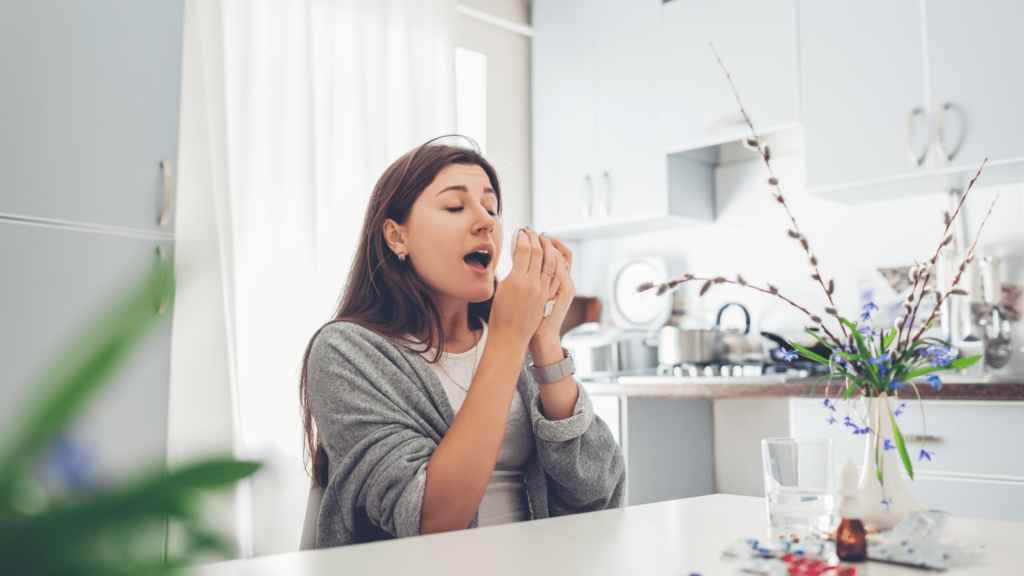This year from June 28th to July 4th, 2020, we celebrated a unique holiday: World Allergy Week 2020. The World Allergy Organization uses this week every year to draw attention to an issue affecting allergy sufferers that could benefit from more awareness. In light of these extraordinary times, the group elected to hold their yearly allergy conference on how COVID-19 effects individuals diagnosed with allergies and asthma.
In celebration of this week of increased awareness, this article will discuss how to distinguish between allergies and COVID-19 symptoms as well as a comparison of allergy symptoms to those of COVID-19, why allergies are worse indoors, and how to get rid of allergy symptoms indoors.
Check out the symptoms
The easiest way to differentiate COVID-19 from common respiratory allergies is by symptoms.
The symptoms of COVID-19 vary depending on many factors, including age, viral load, and previous diagnoses of the patient, but the most common symptoms of COVID-19 infection are listed below:
The most obvious difference between allergies and COVID-19 the presence of a fever in the presentation of COVID-19 and the presence of sneezing in the presentation of seasonal allergies.
How Do COVID-19 Variant Symptoms Compare?
So, what about variant strains of the COVID-19 virus? As the pandemic has progressed, variants like Delta and Omicron have taken center stage as the main contributors to new COVID-19 cases. The question is, do their symptoms vary from the original SARS-CoV-2 strain, and how can we distinguish these from typical signs of allergies?
Both variants carry similar symptoms as the initial COVID-19 virus does but with varying degrees of intensity, and they have been more contagious among people. The Delta variant has been known to cause quicker, more intense side-effects to the respiratory tract. The most recent Omicron variant is quickly and easily spread among people, though its symptoms are often milder than the Delta or SARS-CoV-2 strains. This makes it a little harder to distinguish an Omicron case from a spell of allergies.
What remains the same across the board is that symptoms like a fever, muscle aches, and stomach illness are never signs of allergies, like they are with the COVID-19 virus. Loss of taste and smell are also a common difference; while a clogged nose from allergies may make it harder to taste or smell, this sensory effect comes without a runny or stuffy nose in the case of COVID-19.
The best way to keep yourself healthy and free of COVID-19 is by being cautious of public interactions, monitoring symptoms in any case of exposure, and taking precautionary steps such as vaccination and mask-wearing to prevent its continual spread.
Why are allergies worse indoors?
Allergy sufferers worldwide have seen an uptick in their allergy symptoms during the pandemic for the glaring reason that allergies tend to worsen indoors due to a phenomenon called “indoor air pollution.” Indoor air pollution is caused by mold, pollen, tobacco smoke, household products, pesticides, Gases such as radon and carbon monoxide, asbestos, formaldehyde, lead, and pet dander becoming trapped in the circulating air. Constantly breathing in this stale, polluted air, supplies your lungs with a constant stream of irritants that set off the cascade of allergy symptoms suffers are all too accustomed to. For the most part, the effects of most indoor air allergens are short-lived and the symptoms vanish in clean air.
How to get rid of air allergens
Allergens can be particularly hard to remove from your home or office because, unlike other irritants, many allergens are virtually indetectable. Here are a few ways you can remove them from your environment without having to see them at all:
The best offense is a good defense and the best defense against indoor air allergies is a rigorous and thorough house or office cleaning. A vacuum cleaner using HEPA filters also helps trap dust and particulates from re-entering the air. Rugs and upholstered furniture are the worst offenders for contributing to dirty air.
Your home needs to be able to breathe too and a gunky air filter on your home’s ventilation system can create all kinds of problems for airflow. Combat these issues by maintaining a strict air filter changing schedule and properly maintaining your HVAC system.
The idea of a soft breeze sweeping the bad air out of your home is an alluring one, but the truth is that if the air outside is polluted, all of those pollutants are now on their way into your house. Keeping the windows closed is your best defense against dirty outside air.
An air purifier is an air quality device that is designed to filter and clean the indoor air of any space. The EnviroKlenz Air System is a revolutionary air purification device that utilizes a proprietary earth mineral technology that was explicitly designed to target noxious and toxic chemicals and odors, capturing, and neutralizing these airborne pollutants entirely from the environment without releasing ay by-products back into the environment.
Mobile Air System
✓ Patented earth mineral technology works to attack VOCs and break them down on a compound level
✓ No chemicals or masking agents
✓ Will not release any chemicals back into your environment
✓ Safer and faster at removing VOC’s than traditional carbon filters and PECO air purifiers
EnviroKlenz® Medical Disclaimer:
“Any information that is provided on this website is not for the use by any commercial or personal entity without expressed written consent of the blog author. The material and statements illustrated within this blog are not intended to diagnose, treat, cure, or prevent any diseases or medical conditions. Nor does the author in any way guarantee or validate the validity, totality, or efficacy of any claims and will therefore not be held responsible for the content of any claims. Always consult your medical physician for any specific medical advice or recommendations.”








